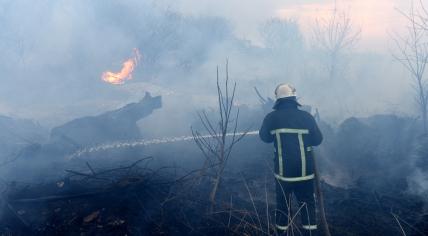
Netherlands to face more uncontrollable wildfires as drought, heat gets worse: experts
The Netherlands will increasingly have to deal with uncontrollable wildfires due to increasing heat and drought. Experts from the Institute of Public Safety (NIPV), the meteorological institute KNMI, and other knowledge centers issued this warning in a joint report.
“Wildfires are more likely to develop into fires that cannot be extinguished and will only stop when there is no more fuel,” the researchers wrote. That fuel consists of, for example, trees and plants. The experts foresee a “major impact on health, well-being, nature, and the economy.”
The fire department, which is currently mainly designed to respond to building fires, must be adapted to face the increasing wildfires, the expert said. According to them, chances are needed in training and in the fire safety rules for companies that are active in nature areas. They would prefer to see a “national action plan” to be better prepared.
Because the Netherlands is covering more of its area in buildings, there is also a threat of a greater impact from wildfires. “People will have to flee more often, direct and indirect damage will occur more often, failure of vital infrastructure leading to cascade effects, and irreparable damage to flora and fauna,” the researchers summed up. “Human health will also be threatened more often.”
“Wildfires are already a regular occurrence in the Netherlands. Especially in drier years. For example, there were nearly a thousand wildfire reports in the very dry 2018. Usually, these fires can still be nipped in the bud, but the risks are increasing due to the rising temperatures and also the increasing precipitation deficit. “All in all, this means that the weather conditions, on average, lead to a greater fire sensitivity of nature. Because it has become warmer and drier, vegetation can dry out more quickly and therefore become fuel for a fire,” said the report.
As climate change continues, the knowledge institutes involved in the research assume that nature will burn more often. Nature’s sensitivity to fire is rising faster in the east of the country than in the west. That is because proximity to the sea has a moderating effect on the maximum temperature.
Wageningen University & Research, VU University Amsterdam, and Deltares also contributed to the report.
Government response
This report is “very useful for the joint approach” to these fires,” said the Ministry of Justice and Security. The Ministry of Agriculture, Nature, and Food Quality said it is currently also considering another piece of advice on forest fires and will give a full response later this year.
An essential aspect of the Dutch approach is prevention. It is precisely in the area of preventing wildfires that ‘profits can be made,” and “investments must be made in the knowledge and skills of the parties involved,” said a spokesperson for the Ministry of Agriculture.
The fire service must also “take steps” when it comes to incident control, according to the Ministry. The fire department will have to adapt to better cope with “climatic developments,” also including extreme weather and flooding.
Forestry service response
The Netherlands must also take measures outside nature reserves to prevent and fight wildfires, said Staatsbosbeheer. The forestry service mentioned, for example, the placement of wells on the edges of nature reserves. A higher groundwater level would also help to prevent natural desiccation.
The risk of wildfires in the Netherlands is increasing due to longer dry periods in recent years, Staatsbosbeheer endorsed the experts’ report. “Wildfires will be an important theme in the coming years,” according to Staatsbosbeheer. “Slow and uncontrollable” fires are particularly dangerous. “Then all the roots and seeds just below the ground also die. That causes much more damage to nature,” said the service.
The forestry service added that the scale on which wildfires occur in the Netherlands differs from recent fires in southern Europe, for example. “There are much larger coniferous forests there, which are more sensitive to fire. In addition, fewer roads and paths run through them, so fire engines cannot approach the fire as easily,” said a spokesperson for the organization.
Reporting by ANP
